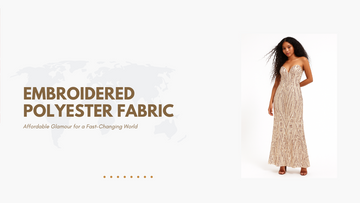Across the world, fashion is changing faster than ever. People no longer want to wear the same outfit again and again. Social media, changing trends, and personal style have made it normal for someone to buy a new outfit for every party or event. But here’s the challenge: not everyone can afford to buy expensive designer clothes each time.
This is where embroidered polyester fabric is making a big difference.
It offers a balance between style and cost. It looks glamorous like silk or georgette, but it’s much cheaper and easier to handle. Whether it’s a wedding outfit, dance costume, or festival look—polyester is now the fabric of choice for millions.
Why Is the Demand for Polyester Growing So Fast?
Today’s generation wants clothes that are:
-
Stylish
-
Affordable
-
Easy to wear and maintain
-
And available quickly
Polyester, especially when it’s embroidered or printed beautifully, gives people all of this. That’s why it's becoming the most-used fabric for:
-
Partywear dresses
-
Stage and dance costumes
-
Festive and wedding fashion
-
Evening gowns and Indo-western styles
Let’s not forget, people now want variety without spending too much. Polyester helps make fashion accessible for everyone.
But Polyester Also Has Its Problems
While polyester is rising in popularity, there are still a few real challenges that the industry faces:
Embroidery is not easy
Polyester is man-made. It doesn’t behave like natural fabrics. Embroidery threads can sometimes melt or not stick well. Machines need to be adjusted, and special care must be taken to make the work clean and beautiful.
Printing can be tricky
You can’t just print anything on polyester and expect it to look great. It needs special printing methods like sublimation or heat transfer to get sharp, lasting designs. If not done properly, colors may fade or designs may look dull.
People still think it’s “cheap”
Even though modern polyester can look and feel luxurious, many people still connect it with low-quality clothing. Changing this mindset takes effort—from designers, brands, and influencers.
It’s not the most eco-friendly
Polyester is made from petroleum-based materials and doesn’t break down naturally. It adds to plastic pollution unless it’s recycled properly (like using rPET). This makes it less sustainable than cotton or silk—unless produced responsibly.
Quality is hard to find
Polyester is everywhere, but embroidered and high-quality polyester is harder to source. Not every fabric supplier understands how to combine the look of high fashion with the structure of synthetic fabric.
Where in the World Is It Most Popular?
The growth is global, but some countries are leading the way:
-
India: For traditional wear like sarees, lehengas, and festive suits—embroidered polyester is widely used because it gives a rich look at a lower price.
-
United States: Prom dresses, dance costumes, Indo-western fashion, and fast fashion brands use it for variety and volume.
-
UAE & Middle East: Long, flowing embroidered gowns and abayas are often made with light, soft polyester blends.
-
West Africa (Nigeria, Ghana): Bold prints and embroidered designs are used in celebration outfits—polyester gives them vibrant colors and affordable volume.
-
Brazil & Mexico: Festive outfits for carnivals and cultural events rely on shiny, stretchy polyester that holds shape and sparkle.
What Types of Outfits Are Made from Embroidered Polyester?
Designers use this fabric for a wide range of clothing styles:
-
Evening gowns with sequin embroidery
-
Festival kurtis with mirror work
-
Dance costumes in stretch polyester net
-
Lehengas made with embroidered satin polyester
-
Tops, skirts, and Indo-western sets with digital prints
Each of these gives a designer look—without a designer price tag.
Why Is It So Affordable?
-
Mass Production: Polyester is made in huge quantities across factories in India, China, and other countries.
-
Low Base Cost: It’s made from synthetic fibers, which are cheaper than natural fibers like silk or cotton.
-
Machine-Friendly: Polyester can be embroidered and printed by machines at high speed.
-
Durability: It doesn’t shrink, wrinkle, or tear easily—so there’s less waste and fewer returns.
Together, these factors make embroidered polyester 60–80% more affordable than other fabrics used for similar fashion.
Case Study: A Boutique's Smart Switch to Embroidered Polyester
Ritika Sharma, owner of a mid-sized boutique in Delhi, used to rely heavily on silk and georgette for her bridal collection. But rising costs were pushing customers away. "We started experimenting with high-quality polyester with embroidery. At first, we were unsure. But the feedback was amazing. Now 70% of our ready-to-wear festive line uses polyester-based fabrics, and our margins are better too."
Stories like this are happening across the globe, as small businesses adapt to meet fast fashion demands.
Innovation Behind the Scenes
Technology has played a major role in polyester’s transformation:
-
Digital Embroidery Software: Designers now create detailed patterns digitally, which embroidery machines can follow exactly—saving time and errors.
-
Heat-Proof Threads: New threads withstand the high heat of embroidery on polyester.
-
Smart Machines: Computer-controlled embroidery machines allow perfect consistency across batches.
Polyester is no longer just "cheap fabric." It’s becoming smart fabric.
The Eco Question: Can Polyester Be Sustainable?
Sustainability matters. While traditional polyester is not eco-friendly, there's a growing shift toward rPET (recycled polyester) made from used plastic bottles.
Brands like Adidas and H&M are already using rPET in fashion. In India, fabric mills are investing in recycling tech. Some even offer "green embroidered polyester" with certifications.
For designers and buyers who care about the planet, rPET is a great middle path.
Where Can You Find the Best Embroidered Polyester?
Finding high-quality embroidered polyester is still a challenge—especially for small designers or startups.
Here’s the solution:
FabricDiary.com
This online fabric marketplace makes it easy to explore and order designer fabrics—especially embroidered polyester—for any project. From digital prints to heavy zardozi embroidery, everything is available at your fingertips. It's great for boutique owners, stylists, and students too.
Madhav Fashion (Surat, India)
If you're looking for custom-made embroidered polyester, Madhav Fashion is a top manufacturer. They offer:
-
On-demand fabric creation
-
Design from scratch (based on your idea or sketch)
-
Small or bulk orders
-
Custom color, embroidery, and finish
You don’t even need to visit them in person—everything from swatches to samples to production can be handled online.
In a time when people want to look their best without spending too much, embroidered polyester fabric has quietly become the star of affordable fashion. It gives you beauty, variety, and smart design—all in one fabric.
And with better technology, cleaner production, and platforms like FabricDiary.com and Madhav Fashion, even small designers can create something big.
So whether you’re launching a fashion label or planning your next festive look, this fabric is your new best friend.
__________________________________________
By Aditya Pandit, International Textile & Fashion Designer Expert / Analytics June 21, 2025






